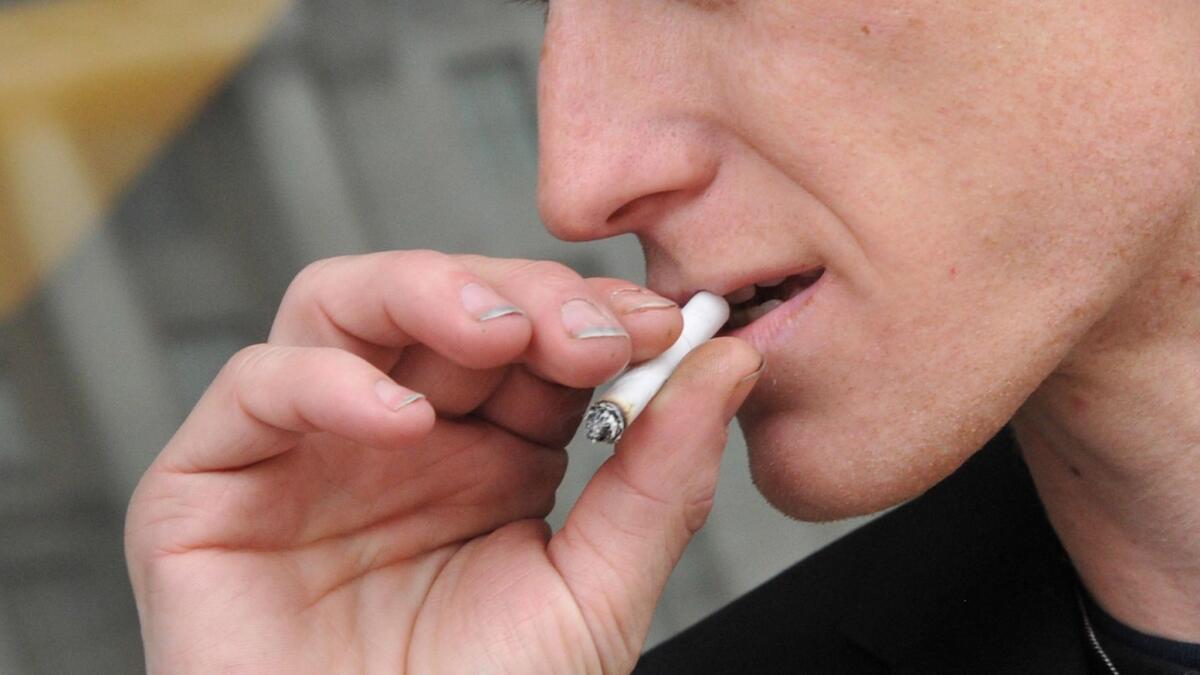Smoking is at a record low in the U.S., but the benefits aren’t shared equally

Cigarette smoking is at an all-time low in the United States, but the benefits of this public health achievement are not being shared equally by all Americans.
A new analysis of health data from the nation’s 500 largest cities shows that the people who live in neighborhoods with the highest smoking rates are more likely to be poor, less likely to be white, and more likely to have chronic heart or lung diseases.
“The degree of inequity was surprising,” said study leader Eric Leas, who conducted the work as a postdoctoral scholar at the Stanford Prevention Research Center.
Smoking may be a choice, but if you want to live a long and healthy life, it’s a bad one. In the U.S., life expectancy is at least 10 years lower for smokers than for nonsmokers, and smoking is responsible for roughly 20% of deaths each year, according to the Centers for Disease Control and Prevention.
The U.S. surgeon general says smoking can be blamed for more than 80% of deaths due to lung cancer (the deadliest type of cancer in the U.S.) and about 80% of deaths due to chronic obstructive pulmonary disease (the country’s third-leading cause of death). Smokers also face increased risks of heart disease, stroke, asthma, diabetes, and at least 10 other kinds of cancer.
Pictures in the News | Tuesday Jan. 8, 2019 »
In 1965, when the National Center for Health Statistics began tracking tobacco use, 42% of U.S. adults were cigarette smokers. By 2017, that figure had declined to 14%.
Leas and his former colleagues from Stanford wondered how the resulting health gains were spread across the country. To find out, they examined data from the 500 Cities Project, a joint effort of the CDC and the Robert Wood Johnson Foundation that gauges health risk factors in 27,204 census tracts in America’s largest cities.
They found that smoking was more popular in some census tracts than others — and that there were certain things these census tracts had in common.
For starters, the people living in neighborhoods with higher smoking rates tended to make less money than people in neighborhoods with lower smoking rates. The researchers calculated that a $10,000 increase in a census tract’s median household income corresponded with a 0.92 percentage-point decrease in smoking prevalence.
In addition, neighborhoods with higher smoking rates were more likely to be populated by African Americans and Latinos, while the reverse was true for non-Hispanic whites. A 10 percentage-point increase in a census tract’s white population corresponded with a 0.84 percentage-point decrease in the prevalence of smoking.
The Stanford team also found that the popularity of smoking and the prevalence of diseases rose or fell in tandem. For instance, if the smoking rate in a neighborhood were to increase from 10.7% (the 10th percentile of all census tracts) to 27.6% (the 90th percentile), the prevalence of coronary heart disease would rise by 27%, asthma would jump by 39%, and chronic obstructive pulmonary disease would climb by 120%.
In each of the 500 cities, the researchers quantified the degree of “smoking prevalence inequity” on a scale from 0 (perfect equity) to 1 (complete inequity). All cities in the study had a score of at least 0.03, representing at least a small degree of inequity, and the bulk of them had scores between 0.1 and 0.15. The most inequitable city in America was Washington, D.C., with a score of 0.23.
Leas said he was amazed by the differences in the nation’s capital: The smoking prevalence in some neighborhoods was 8.8%, while in others it reached 49.1%.
“A rate of 49.1% is higher even than where the national average was in the 1960s, highlighting how far many neighborhoods need to come to catch up to the national trends,” said Leas, who is now an assistant adjunct professor at the UC San Diego School of Medicine.
Health experts make a distinction between inequalities and inequities. Some amount of health inequality may be unavoidable, such as when a genetic variant makes a person more vulnerable to a particular disease. However, when an unequal outcome could have been avoided, you have a case of inequity.
The researchers proposed several policy measures to combat the inequities they documented.
For instance, people in neighborhoods with higher smoking rates were more likely to encounter stores selling cigarettes and other tobacco products — an increase of five tobacco retailers in a census tract corresponded with a 0.11 percentage-point increase in smoking prevalence there, the researchers found. Regulations aimed at “limiting the quantity, location, and type of tobacco retailers” in an area might lead to reductions in smoking there, they wrote.
Raising taxes on cigarettes to make them more expensive would probably reduce demand among low-income smokers, helping to erase at least some of the inequity, they added. The findings also suggest that smoking cessation programs would do more good if they were “targeted to resource-poor communities,” they wrote.
The study was published Monday by the journal JAMA Internal Medicine.
Follow me on Twitter @LATkarenkaplan and “like” Los Angeles Times Science & Health on Facebook.
MORE IN SCIENCE







